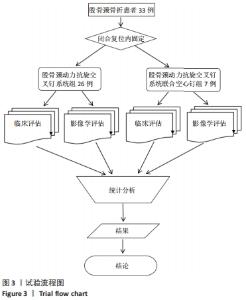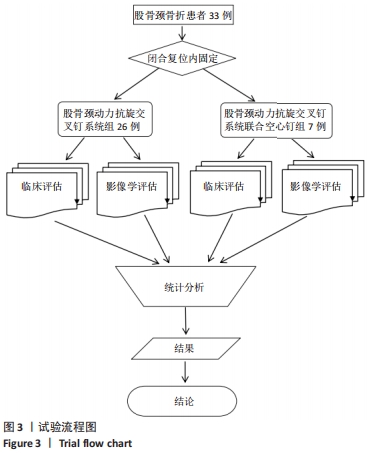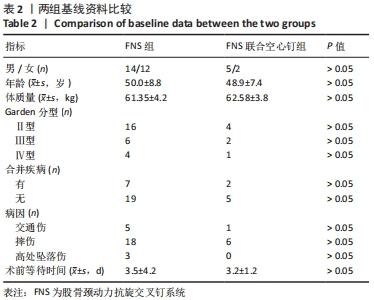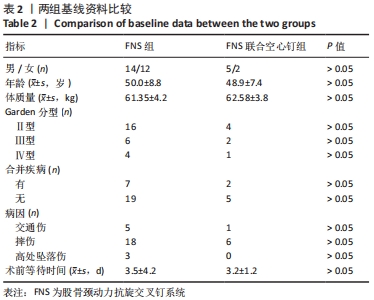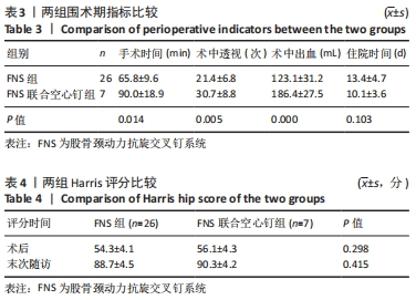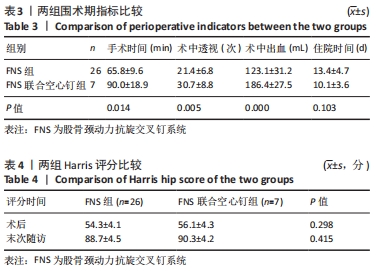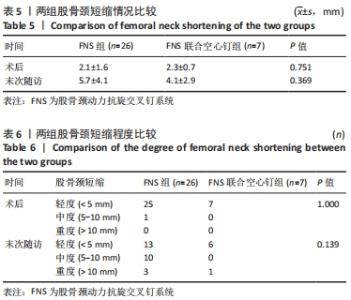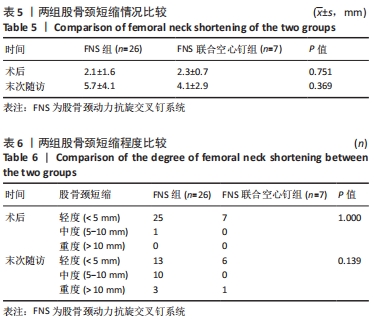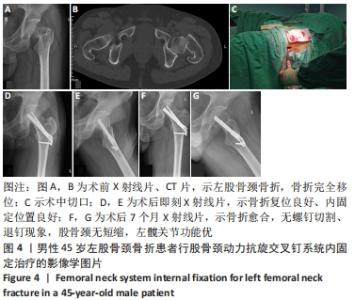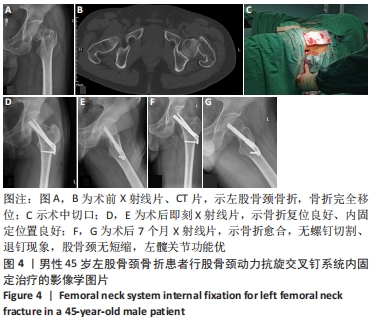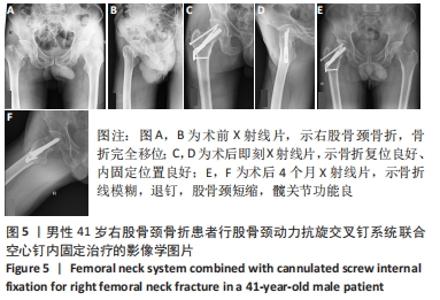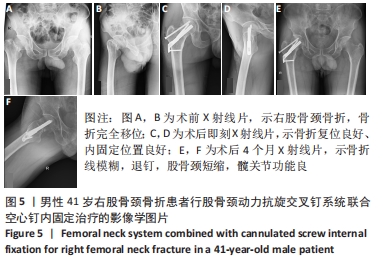Chinese Journal of Tissue Engineering Research ›› 2022, Vol. 26 ›› Issue (33): 5329-5334.doi: 10.12307/2022.745
Previous Articles Next Articles
Femoral neck system or combined cannulated screws for femoral neck fracture
Li Yongwang1, Long Yubin1, He Rongli2, An Ming1, Zhang Qian1, Qi Hui1, Han Zhe1, Ma Wenhai1
- 1Third Department of Orthopedics, Baoding First Central Hospital, Baoding 071000, Hebei Province, China; 2Department of Gastroenterology, Baoding Second Hospital, Baoding 071000, Hebei Province, China
-
Received:2021-11-03Accepted:2021-12-15Online:2022-11-28Published:2022-03-31 -
Contact:Ma Wenhai, Chief physician, Third Department of Orthopedics, Baoding First Central Hospital, Baoding 071000, Hebei Province, China -
About author:Li Yongwang, Master, Associate chief physician, Third Department of Orthopedics, Baoding First Central Hospital, Baoding 071000, Hebei Province, China -
Supported by:Science and Technology Plan Project of Baoding, No. 2041ZF260 (to LYB)
CLC Number:
Cite this article
Li Yongwang, Long Yubin, He Rongli, An Ming, Zhang Qian, Qi Hui, Han Zhe, Ma Wenhai. Femoral neck system or combined cannulated screws for femoral neck fracture[J]. Chinese Journal of Tissue Engineering Research, 2022, 26(33): 5329-5334.
share this article
Add to citation manager EndNote|Reference Manager|ProCite|BibTeX|RefWorks
| [1] 张长青,张英泽,余斌,等.成人股骨颈骨折诊治指南[J].中华创伤骨科杂志,2018,20(11):921-928. [2] STOFFEL K, ZDERIC I, GRAS F, et al. Biomechanical Evaluation of the Femoral Neck System in Unstable Pauwels III Femoral Neck Fractures:A Comparison with the Dynamic Hip Screw and Cannulated Screws. J Orthop Trauma. 2017;31(3):131-137. [3] SCHOPPER C, ZDERIC I, MENZE J, et al. Higher stability and more predictive fixation with the Femoral Neck System versus Hansson Pins in femoral neck fractures Pauwels II.J Orthop Translat. 2020;24: 88-95. [4] MUNDI S, PINDIPROLU B, SIMUNOVIC N, et al. Similar mortality rates in hip fracture patients over the past 31 years. Acta Orthop. 2014; 85(1):54-59. [5] KLOP C, WELSING PM, COOPER C, et al. Mortality in British hip fracture patients, 2000-2010: a population-based retrospective cohort study. Bone. 2014;66:171-177. [6] ROCHE JJ, WENN RT, SAHOTA O, et al. Effect of comorbidities and postoperative complications on mortality after hip fracture in elderly people: prospective observational cohort study. BMJ. 2005;331(7529): 1374. [7] BHANDARI M, DEVEREAUX PJ, SWIONTKOWSKI MF, et al. Internal fixation compared with arthroplasty for displaced fractures of the femoral neck.A meta-analysis. J Bone Joint Surg Am. 2003;85(9):1673-1681. [8] ASNIS SE, WANEK-SGAGLIONE L. Intracapsular fractures of the femoral neck. Results of cannulated screw fixation. J Bone Joint Surg Am. 1994; 76(12):1793-1803. [9] WANG Z, YIN Y, LI Q, et al. Comparison of early complications between the use of a cannulated screw locking plate and multiple cancellous screws in the treatment of displaced intracapsular hip fractures in young adults: a randomized controlled clinical trial. J Orthop Surg Res. 2018;13(1):201. [10] JOHNSON JP, BORENSTEIN TR, WARYASZ GR, et al. Vertically Oriented Femoral Neck Fractures: A Biomechanical Comparison of 3 Fixation Constructs. J Orthop Trauma. 2017;31(7):363-368. [11] PARKER MJ. Results of internal fixation of Pauwels type-3 vertical femoral neck fractures. J Bone Joint Surg Am. 2009;91(2):490-491. [12] SONG HK, CHOR HJ, YANG KH. Risk factors of avascular necrosis of the femoral head and fixation failure in patients with valgus angulated femoral neck fractures over the age of 50 years. Injury. 2016;47(12): 2743-2748. [13] NYHOLM AM, PALM H, SANDHOLDT H, et al.Osteosynthesis with parallel implants in the treatment of femoral neck fractures : minimal effect of implant position on risk of reoperation. J Bone J Surg Am. 2018;100(19):1682-1690. [14] Park YC, Shin SC, Kang HJ, et al. Comparison of femoral neck shortening and outcomes between in situ fifixation and fifixation after reduction for severe valgus-impacted femoral neck fractures. Injury. 2021;3:569-574. [15] 许新忠,常菁,余水生,等. 股骨颈系统固定治疗股骨颈骨折的近期疗效分析[J].中华创伤骨科杂志,2020,22(7):624-627. [16] 杨家赵,周雪锋,朱万博,等. 股骨颈动力交叉钉系统与倒三角形空心螺钉固定治疗成人股骨颈骨折的疗效比较[J].中华创伤骨科杂志,2021,23(9):761-768. [17] 杨家赵,周雪锋,李黎,等. 股骨颈动力交叉钉系统和倒三角空心钉治疗Pauwels Ⅲ型股骨颈骨折疗效比较[J].中国修复重建外科杂志,2021,35(9):1111-1118. [18] 范智荣,苏海涛,周霖,等. 新型股骨颈内固定系统治疗不稳定性股骨颈骨折的有限元分析 [J]. 中国组织工程研究,2021,25(15): 2321-2328. [19] STOFFEL K, ZDERIC I, GRAS F, et al. Biomechanical evaluation of the femoral neck system in unstable Pauwels II femoral neck fractures: A comparison with the dynamic hip screw and cannulated screws. J Orthop Trauma. 2017;31(3):131-137. [20] SCHOPPER C, ZDERIC I, MENZE J, et al. Higher stability and more predictive fixation with the femoral neck system versus Hansson pins in femoral neck fractures Pauwels II. J Orthop Translat. 2020;24:88-95. [21] 杨亚军,马涛,张小钰,等. 股骨颈动力交叉钉系统治疗股骨颈骨折近期疗效[J].中国修复重建外科杂志,2021,35(5):539-543. [22] FELTON J, SLOBOGEAN GP, JACKSON SS, et al. Femoral neck shortening after hip fracture fixation is associated with inferior hip function: results from the FAITH trial. J Orthop Trauma. 2019;33(10):487-496 . [23] SLOBOGEAN GP, STOCKTON DJ, ZENG BF, et al. Femoral neck shortening in adult patients under the age of 55 years is associated with worse functional outcomes: analysis of the prospective multi-center study of hip fracture outcomes in China (SHOC). Injury. 2017;48(8):1837-1842. [24] ZLOWODZKI M, AYENI O, PETRISOR BA, et al. Femoral Neck Shortening After Fracture Fixation With Multiple Cancellous Screws: Incidence and Effect on Function. J Trauma. 2008;64(1):163-169. [25] 严才平,王星宽,向超,等. 股骨颈动力交叉钉系统与空心加压螺钉治疗中青年股骨颈骨折的疗效比较[J].中国修复重建外科杂志, 2021,35(10):1286-1292. [26] 胡家朗,李绍刚,陈明,等. 新型股骨颈动力加压锁定钉板系统治疗股骨颈骨折[J].中华创伤骨科杂志,2019,21(11):939-944. [27] 霍喜卫,李东风,胡成栋,等. 股骨颈骨折术后股骨头缺血坏死的发生率及危险因素分析[J]. 蚌埠医学院学报,2021,46(8):1050-1053. [28] 邓思煜,谭绍林,严国华,等. 新型股骨颈动力加压锁定钉板系统治疗股骨颈骨折[J].中华实验外科杂志,2021,38(10):1959. [29] YANG Y, MA T, ZHANG X, et al. Short-term effectiveness of femoral neck system in the treatment of femoral neck fracture. Zhongguo Xiu Fu Chong Jian Wai Ke Za Zhi. 2021;35(5):539-543. [30] HU H, CHENG J, FENG M, et al. Clinical outcome of femoral neck system versus cannulated compression screws for fixation of femoral neck fracture in younger patients. J Orthop Surg Res. 2021;16(1):370. [31] YAN C, WANG X, XIANG C, et al. Comparison of effectiveness of femoral neck system and cannulate compression screw in treatment of femoral neck fracture in young and middle-aged patients. Zhongguo Xiu Fu Chong Jian Wai Ke Za Zhi. 2021;35(10):1286-1292. [32] HE C, LU Y, WANG Q, et al. Comparison of the clinical efficacy of a femoral neck system versus cannulated screws in the treatment of femoral neck fracture in young adults. BMC Musculoskelet Disord. 2021;22(1):994. [33] YANG J, ZHOU X, LI L, et al. Comparison of femoral neck system and inverted triangle cannulated screws fixations in treatment of Pauwels typle femoral neck fractures. Zhongguo Xiu Fu Chong Jian Wai Ke Za Zhi. 2021;35(9):1111-1118. [34] TANG Y, WANG G. Comment on “Clinical outcome of femoral neck system versus cannulated compression screws for fixation of femoral neck fracture in younger patients”. J Orthop Surg Res. 2021;16(1):553. [35] VAZQUEZ O, GAMULIN A, HANNOUCHE D, et al. Osteosynthesis of non-displaced femoral neck fractures in the elderly population using the femoral neck system (FNS): short-term clinical and radiological outcomes. J Orthop Surg Res. 2021;16(1):477. [36] CINTEAN R, PANKRATZ C, HOFMANN M, et al. Early Results in Non-Displaced Femoral Neck Fractures Using the Femoral Neck System. Geriatr Orthop Surg Rehabil. 2021;12:21514593211050153. [37] NIBE Y, MATSUMURA T, TAKAHASHI T, et al. A comparison between the femoral neck system and other implants for elderly patients with femoral neck fracture: A preliminary report of a newly developed implant. J Orthop Sci. 2021 2:S0949-2658(21)00153-6. |
| [1] | Yuan Jiabin, Zhu Zongdong, Tang Xiaoming, Wei Dan, Tan Bo, Xiao Chengwei, Zhao Ganlinwei, Liao Feng. Classification and reduction strategies for irreducible intertrochanteric femoral fracture based on anatomy [J]. Chinese Journal of Tissue Engineering Research, 2022, 26(9): 1341-1345. |
| [2] | Pan Baoshun, Fang Zhen, Gao Mingjie, Fang Guiming, Chen Jinshui. Design for posterior atlantoaxial internal fixation system with fusion cage based on imaging data [J]. Chinese Journal of Tissue Engineering Research, 2022, 26(9): 1372-1376. |
| [3] | Li Kun, Gao Erke, Xiong Feng, Wang Xing, Wu Danqi, Li Zhijun, Zhang Shaojie, Liu Yanan, Duo Lan, Li Ziyu. Feasibility of axial transpedicle screw internal fixation in children aged 1 to 6 years [J]. Chinese Journal of Tissue Engineering Research, 2022, 26(9): 1383-1387. |
| [4] | Zhuang Zhikun, Wu Rongkai, Lin Hanghui, Gong Zhibing, Zhang Qianjin, Wei Qiushi, Zhang Qingwen, Wu Zhaoke. Application of stable and enhanced lined hip joint system in total hip arthroplasty in elderly patients with femoral neck fractures complicated with hemiplegia [J]. Chinese Journal of Tissue Engineering Research, 2022, 26(9): 1429-1433. |
| [5] | Zhang Xinlong, Ci Wentao, Luo Kaiwen, Yan shi. Internal fixation failure after proximal femoral nail antirotation: causes and reoperation strategies [J]. Chinese Journal of Tissue Engineering Research, 2022, 26(6): 973-979. |
| [6] | Wen Mingtao, Liang Xuezhen, Li Jiacheng, Xu Bo, Li Gang. Mechanical stability of Sanders II type calcaneal fractures fixed by two internal fixation methods [J]. Chinese Journal of Tissue Engineering Research, 2022, 26(6): 838-842. |
| [7] | Yang Jun, Yang Qun, Zhang Rui, Jiang Chang. A novel slidable pedicle screw-rod system for lumbar tuberculosis: promoting bone graft fusion by producing stress stimulation to fused segment [J]. Chinese Journal of Tissue Engineering Research, 2022, 26(6): 914-918. |
| [8] | Sheng Xiaolei, Liu Su, Wang Jin, Zhao Lei, Zhu Yi, Zhang Wei, Gu Qi, Yuan Feng, Tian Shoujin, Ge Jianfei. Femoral neck fractures in middle-aged and young adults using femoral neck system assisted by 3D printed guide plate [J]. Chinese Journal of Tissue Engineering Research, 2022, 26(33): 5290-5296. |
| [9] | Xu Wei, Li Zhifei, Wan Tong, Yu Weibo, Zhang Yisheng, Zhou Jinyan, Bu Xianzhong, Zhong Yuanming. Application of height adjustable titanium fusion cage in endoscopic lumbar fusion [J]. Chinese Journal of Tissue Engineering Research, 2022, 26(33): 5335-5341. |
| [10] | Liang Haoran, Zhou Xin, Yang Yanfei, Niu Wenjie, Song Wenjie, Ren Zhiyuan, Wang Xueding, Liu Yang, Duan Wangping. Pathogenesis of femoral head necrosis after internal fixation of femoral neck fractures in young adults [J]. Chinese Journal of Tissue Engineering Research, 2022, 26(3): 456-460. |
| [11] | Yang Ruijia, Jiang Lingkai, Dong Zhengquan, Wang Yunfei, Ma Zhou, Cong Linlin, Guo Yanjing, Gao Yangyang, Li Pengcui. Open reduction and internal fixation versus circular external fixation for tibial plateau fractures: a meta-analysis [J]. Chinese Journal of Tissue Engineering Research, 2022, 26(3): 480-486. |
| [12] | Cai Feng, Yu Bo, Zeng Duo, Chen Qincan, Liao Qi. Cortical bone trajectory in elderly patients with osteoporosis of lumbar disease [J]. Chinese Journal of Tissue Engineering Research, 2022, 26(3): 403-407. |
| [13] | Feng Shuo, Liu Bo, He Da. Effects of robot-assisted percutaneous minimally invasive pedicle screw placement in oblique lumbar interbody fusion [J]. Chinese Journal of Tissue Engineering Research, 2022, 26(3): 408-413. |
| [14] | Hu Pengyu, Yu Zhiping, Jia Guanghou, Cong Zhichao, Cong Haibo. Adjuvant treatment of nonunion of tibial fractures with platelet-rich plasma evaluated by bone turnover markers [J]. Chinese Journal of Tissue Engineering Research, 2022, 26(27): 4367-4373. |
| [15] | Tian Chong, Gao Bo, Yu Hongwei, Wang Pei. Theoretical research and technical application of bone repair materials in the treatment of calcaneal fractures [J]. Chinese Journal of Tissue Engineering Research, 2022, 26(22): 3586-3591. |
| Viewed | ||||||
|
Full text |
|
|||||
|
Abstract |
|
|||||
